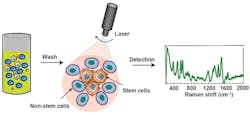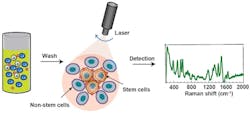Raman scattering method can detect pluripotent stem cells with high sensitivity
Researchers at Emory University (Atlanta, GA) have developed an extremely sensitive technique for detecting pluripotent stem cells, which—despite their potential applications—can become tumors when transplanted.
The technique uses gold nanoparticles and Raman scattering, and the nanoparticles are conjugated with antibodies against the SSEA-5 or TRA-1-60 proteins that are found on the surfaces of stem cells. This could someday allow researchers to ensure that the stem-cell-derived cardiac muscle, neural progenitor, or pancreas cells are as pure as possible.
In a paper describing the work, the researchers report that their Raman scattering technology can identify one stem cell out of a million differentiated cells—a level of sensitivity that is enough to detect stem cells at the scale needed for clinical applications. The research team's surface-enhanced Raman scattering (SERS) assays may facilitate safety assessment of cell preparations for transplantations that require a large quantity of cells, and are cost-effective, easy to use, and can be done within an hour, the researchers say.
Full details of the work appear in the journal Biomaterials; for more information, please visit http://dx.doi.org/10.1016/j.biomaterials.2016.07.033.

